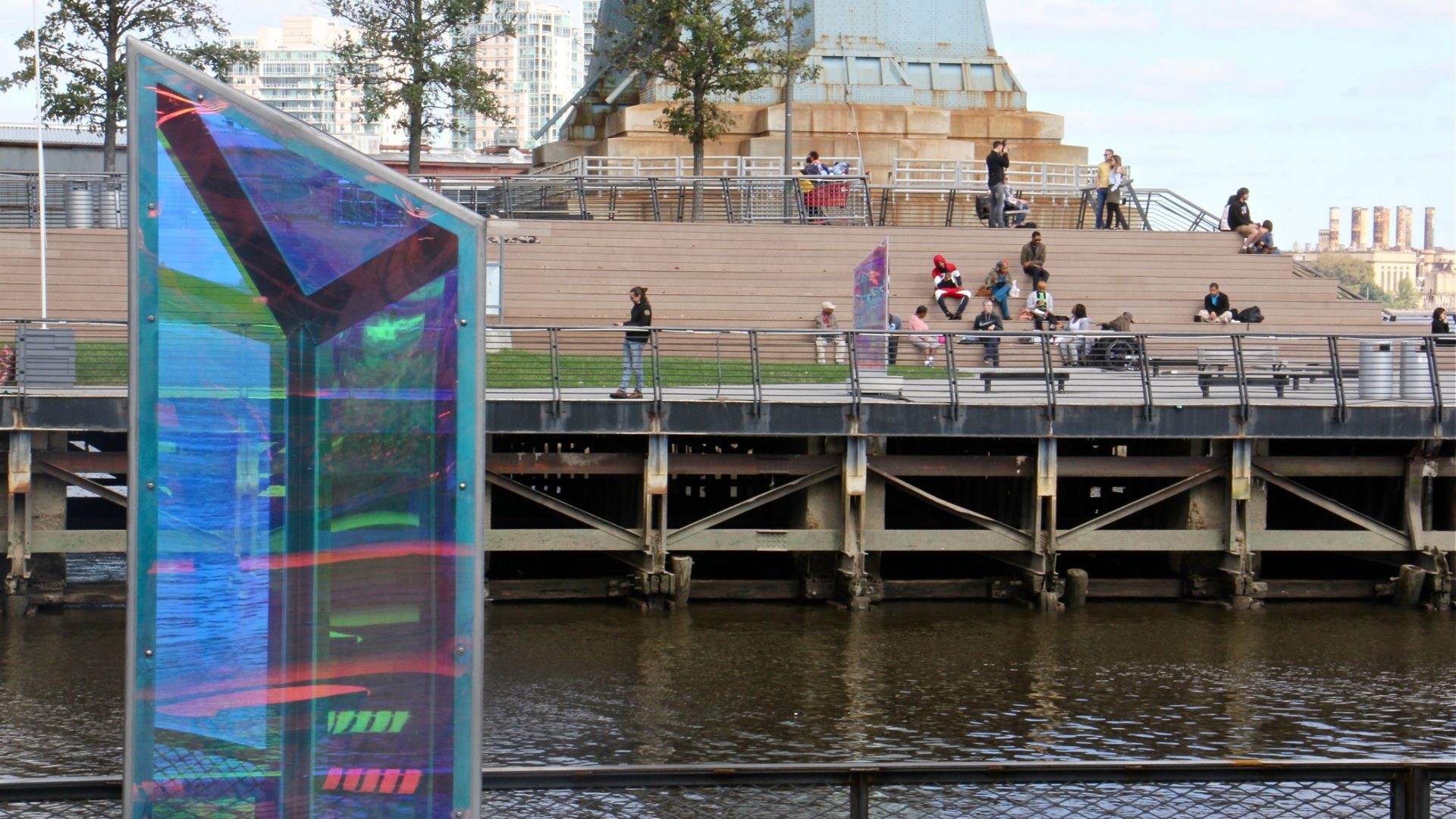
The Cherry Street Pier's artwork is echoed on the neighboring Race Street Pier.
Emma Lee / WHYY

The Cherry Street Pier's artwork is echoed on the neighboring Race Street Pier.
Emma Lee / WHYY

Emma Lee / WHYY
The Cherry Street Pier's artwork is echoed on the neighboring Race Street Pier.
(Philadelphia) — The city’s plan for the Delaware River waterfront has had its ups and downs. First there was the PMC One Water Street fight, then the Squilla building-height debate, and most recently, the community uproar over Bart Blatstein’s Super Wawa.
But the new modifications to the Central Delaware zoning overlay, presented in a City Council bill and approved by the Planning Commission Tuesday afternoon, indicate that the city’s been learning from its developers’ mistakes. Here’s what the bill changed and why it matters.
Housing is currently counted as an “active use” under the overlay. Consequently, most developers have opted to pursue residential uses, often in the form of rowhouses. That means that the new riverfront is building more separated, suburb-style blocks and avoiding other forms of active use like retail, restaurants, libraries or exhibition spaces that could potentially attract pedestrian activity.
The new overlay changes, according to city planner and presenter Mason Austin, limit the percentage of housing that can front on Columbus and Delaware avenues, as well as on roads designated as river access streets. Austin also mentioned that the changes place restrictions on gas stations, which will no longer be allowed anywhere in the overlay with the exception of industrial parcels. Presumably, planners intend these changes to foster development that will draw neighborhood residents to the waterfront.
PMC Property Group’s One Water Street was one of the first projects zoned under the Central Delaware waterfront overlay. At the time, the soaring luxury apartment building made the most of its development bonuses — including a 24-foot height bonus for provision of public space. But as the Inquirer’s architecture critic Inga Saffron pointed out, “If you visit the site, you might be hard-pressed to identify the ‘public open space’ that PMC created to satisfy the bonus requirement. Is it the planted berm in front of the building? The generous driveway? Or maybe the row of concrete benches along Columbus Boulevard? Whichever it is, it’s a pretty stingy contribution to the public realm.”
City planning officials realized it wasn’t enough to simply require public space. They had to specify that the developer create areas that explicitly welcomed the public with their design.
The overlay’s new requirements for designated public space add two key things. First, the area needs to meet a minimum width and depth of 50 feet at its narrowest and shallowest points. Second, the area needs to be adjacent to a public street, river access street or trail — in other words, easily accessible to the actual public.
Bart Blatstein’s shuffle-and-switch on the Super Wawa proposal may have made it to the zoning board, but it didn’t fool the neighborhood — or the city. Blatstein previously skirted the overlay requirements by switching the gas station and convenience store locations, as well as by designating a small parcel along the edge of Columbus as a landscaping addition and claiming that the definition of “frontage” allowed his development technical legality.
His proposal hasn’t yet been granted the special exemption it needs to continue, but the city is making sure no one else can pull anything like it. The new amendment reads: “A lot will be deemed to have frontage on a given street or watercourse if any portion of the lot is within 75 ft. of the given street or watercourse and there is no permanent structure on any parcels located entirely or partially within any area that separates the parcel from the given street or watercourse.”
In other words, the rules now guard against landscaping or driveway buffers that exempt waterfront developers from waterfront zoning.
Finally, the new overlay further encourages the creation of retail space, public space, mixed-income housing and even stormwater management by adding height bonuses — up to 48 feet of additional height allowance. If developers choose to go above and beyond those requirements and submit to an optional special review, they’ll receive extra benefits, including exemption from building-height maximums and parking minimums.
The amended overlay code also specifies that Licensing and Inspection will not issue a zoning permit until the developer meets with the planning commission and the commission certifies that “all proposed facades and public spaces are in harmony with the intended character of the…overlay district.” The language of “in harmony with” — aside from conjuring flashbacks to middle-school choir rehearsal — indicates the planning commission’s commitment to not only the rules, but the intention behind the Central Delaware overlay.
WHYY is the leading public media station serving the Philadelphia region, including Delaware, South Jersey and Pennsylvania. This story originally appeared on WHYY.org.

A collection of interviews, photos, and music videos, featuring local musicians who have stopped by the WITF performance studio to share a little discussion and sound. Produced by WITF’s Joe Ulrich.
The days of journalism’s one-way street of simply producing stories for the public have long been over. Now, it’s time to find better ways to interact with you and ensure we meet your high standards of what a credible media organization should be.